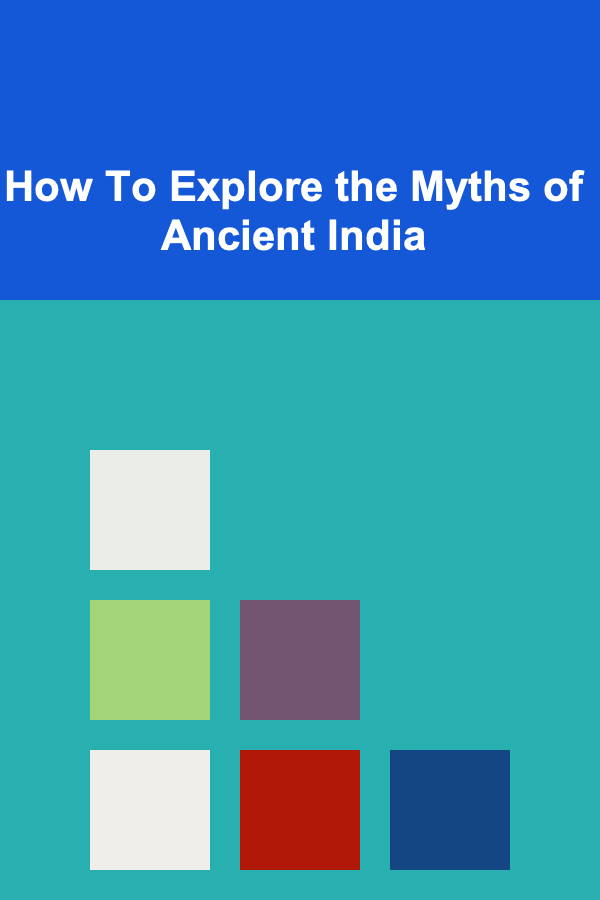
How To Explore the Myths of Ancient India
ebook include PDF & Audio bundle (Micro Guide)
$12.99$6.99
Limited Time Offer! Order within the next:

India, one of the oldest civilizations in the world, is steeped in a rich tradition of myths, legends, and spiritual narratives. The myths of ancient India are not merely stories or allegories; they represent the heart of Indian culture, philosophy, and religion. These myths have shaped the spiritual, cultural, and societal norms of the Indian subcontinent for millennia. They provide insight into the human condition, the nature of the divine, and the moral order of the world. Understanding these myths offers a window into the ancient Indian worldview, one that sees the universe as interconnected and governed by cosmic laws.
The myths of ancient India are embedded in its sacred texts, such as the Vedas , the Upanishads , the Mahabharata , the Ramayana , and the Puranas. These texts offer not just stories but elaborate systems of thought that delve into cosmology, ethics, dharma (righteousness), and moksha (liberation). They are rich with symbolism, deep philosophical insights, and narratives that reveal the nature of the divine and its relationship with the human world.
In this article, we will explore how one can engage with and understand the myths of ancient India. This exploration will provide insight into the primary sources of these myths, their symbolic meanings, and how they relate to the spiritual and philosophical traditions of India.
The Importance of Ancient Indian Myths
Ancient Indian myths are more than mere tales passed down through generations; they are a reflection of the deep spiritual and philosophical traditions of India. These myths serve as vehicles for conveying complex ideas about the nature of reality, the workings of the universe, and the moral imperatives that govern human life. Here are some key reasons why exploring these myths is essential:
1.1 A Window into the Indian Worldview
The myths of ancient India provide a comprehensive worldview that integrates cosmology, spirituality, and ethics. For example, the concept of dharma (righteousness) is central to many of these myths. In the Mahabharata, the epic war is fought over the principles of dharma, where the characters struggle to understand what is just and righteous in a complex world.
1.2 Spiritual and Philosophical Insights
The myths are often deeply intertwined with the spiritual and philosophical teachings of Hinduism, Buddhism, and Jainism. Through these myths, ancient Indian thinkers explored fundamental questions about the nature of existence, the self, and the divine. In particular, the idea of the self as an eternal soul (Atman) and its relationship with the universal reality (Brahman) is a core theme in these myths.
1.3 Moral Lessons and Ethical Framework
Many of the myths contain moral lessons that emphasize virtue, wisdom, and the consequences of one's actions. The stories of deities like Lord Rama, Lord Krishna, and others offer examples of how to navigate life's challenges with integrity, compassion, and self-control.
1.4 Cultural Legacy and Artistic Expression
These myths have influenced not just the religious and philosophical discourse but also the arts, literature, and culture of India. Classical dance, drama, and music often draw on these ancient stories, presenting them in new forms. Even modern literature and cinema in India are shaped by these age-old myths.
Primary Sources of Ancient Indian Myths
To understand the myths of ancient India, it is crucial to first familiarize oneself with the texts that contain them. These myths have been preserved and passed down through a rich tradition of oral storytelling, manuscripts, and scriptures. The following are the primary sources of ancient Indian myths:
2.1 The Vedas
The Vedas are the oldest and most authoritative scriptures of ancient India, dating back to around 1500 BCE. They consist of hymns, chants, and rituals dedicated to various deities. The Rigveda, the oldest of the Vedas, contains hymns that describe the cosmic order and the primordial forces that govern the universe.
The Vedas also introduce the concept of Brahman (the ultimate reality) and Atman (the individual soul), two key ideas that form the foundation of much of Indian philosophy. Though the Vedas are more concerned with ritual and cosmology than narrative myth, they set the stage for many of the myths that appear in later texts.
2.2 The Upanishads
The Upanishads, often considered the concluding portion of the Vedic texts, shift the focus from ritual to philosophy. They explore the nature of existence, the relationship between the individual soul (Atman ) and the supreme soul (Brahman ), and the concept of ultimate liberation (moksha). The Upanishads use stories, parables, and metaphors to communicate profound metaphysical ideas.
While not traditionally mythological in the sense of epic tales or gods, the Upanishads contain mythic themes, such as creation myths, the nature of the universe, and the journey of the soul after death. The Brihadaranyaka Upanishad, for instance, offers a mythological explanation of the creation of the universe and the interdependence of all beings.
2.3 The Ramayana
One of the two great epics of India, the Ramayana is a narrative poem attributed to the sage Valmiki. It tells the story of Lord Rama, his wife Sita, and his battle against the demon king Ravana. The Ramayana is not only a tale of heroism, devotion, and duty but also a philosophical work that explores themes such as the nature of good and evil, loyalty, sacrifice, and dharma.
Rama's journey is emblematic of the hero's journey, and his adherence to dharma despite facing immense personal suffering serves as a model of virtuous living. This epic has had an enormous cultural and religious influence, inspiring countless retellings in various forms, from theatre to film.
2.4 The Mahabharata
The Mahabharata is the longest epic in the world, consisting of around 100,000 verses. It tells the story of the great war between the Pandavas and the Kauravas, two branches of the same royal family. The Mahabharata is not just a narrative of battle but a profound exploration of ethics, politics, and the human condition.
One of the key sections of the Mahabharata is the Bhagavad Gita, a philosophical dialogue between Prince Arjuna and Lord Krishna. In this dialogue, Krishna teaches Arjuna about duty, righteousness, and the nature of the self, providing deep spiritual insights that resonate across time and cultures.
2.5 The Puranas
The Puranas are a genre of texts that contain stories of gods, goddesses, heroes, and cosmic events. These texts were written over a long period, from around 300 CE to 1000 CE, and contain a vast amount of mythology. The Vishnu Purana , the Shiva Purana , and the Bhagavata Purana are some of the most important Puranas.
The Puranas tell the stories of the creation of the world, the genealogies of gods and sages, and the exploits of divine beings. They often focus on the deeds of the Hindu gods, particularly Vishnu, Shiva, and Brahma, and provide the foundation for many of the religious practices and festivals in India.
Key Themes in Ancient Indian Myths
The myths of ancient India explore a variety of themes that continue to resonate in contemporary life. Some of the most prominent themes in these myths include:
3.1 Creation Myths
Creation myths explain the origins of the universe, the gods, and human beings. In Hindu mythology, there are various creation stories, one of the most well-known being the story of the cosmic egg or Brahmanda . In this myth, the universe is created from a golden egg, and the gods emerge from it. Similarly, in the Rigveda, the creation hymn describes the emergence of the cosmos from a primal, undifferentiated state.
3.2 The Divine and the Human
Many of the myths in ancient India revolve around the interaction between the divine and the human. Gods and goddesses are often depicted as taking human form or interacting with humans to teach important lessons or to fulfill cosmic duties. For instance, Lord Krishna, in the Mahabharata and the Bhagavad Gita, is both a divine being and a teacher, guiding Arjuna through his moral and existential crisis.
3.3 Dharma and Moral Order
The concept of dharma ---the righteous path or moral order---is central to many of the myths of ancient India. The Ramayana and Mahabharata both explore the challenges of adhering to dharma in difficult circumstances. The heroes of these epics, such as Rama and Arjuna, face moral dilemmas that test their commitment to righteousness.
3.4 Cycles of Time
In many Indian myths, time is understood as cyclical rather than linear. The concept of yugas (ages) in Hindu mythology describes the four stages of cosmic evolution: Satya Yuga (age of truth), Treta Yuga (age of ritual), Dvapara Yuga (age of conflict), and Kali Yuga (age of decline). These cycles of time reflect the rise and fall of civilizations, the eternal return, and the moral decay of humanity over time.
3.5 Transformation and Liberation
Many of the myths focus on the idea of transformation, both on a cosmic scale and in terms of individual growth. The idea of moksha ---the liberation of the soul from the cycle of birth and rebirth---is central to many myths. The journey of the soul, its struggles with attachment, and its eventual liberation is a recurring theme in texts like the Bhagavad Gita and the Upanishads.
How to Explore the Myths of Ancient India
Exploring the myths of ancient India requires a multifaceted approach. Here are some ways you can begin to delve into these ancient stories and their deeper meanings:
4.1 Study the Sacred Texts
The most direct way to explore Indian myths is to study the primary texts that contain them. Reading translations and commentaries on the Vedas , Upanishads , Mahabharata , Ramayana , and Puranas will provide a rich understanding of these myths. It's important to approach these texts with an open mind, as they are complex and often contain layers of symbolism and philosophical depth.
4.2 Engage with Secondary Sources
Secondary sources such as academic books, articles, and lectures on Indian mythology can offer valuable insights into the context, symbolism, and philosophical themes of these myths. Scholars in the fields of comparative religion, anthropology, and philosophy have written extensively about Indian myths, providing interpretations and explanations that can help clarify their meaning.
4.3 Understand the Cultural Context
Ancient Indian myths are deeply embedded in the culture, history, and spiritual practices of India. To fully appreciate these myths, it's essential to understand the cultural and religious context in which they emerged. Visiting temples, attending festivals, or participating in cultural events can provide a more immersive experience and deepen your understanding of how these myths are still relevant in contemporary India.
4.4 Reflect on the Philosophical and Spiritual Lessons
Many of the myths are meant to convey spiritual and philosophical teachings. Take time to reflect on the deeper messages of the myths, such as the nature of the self, the meaning of suffering, and the importance of virtue. Engaging with these teachings can provide personal insights and inspire inner growth.
Conclusion
The myths of ancient India offer a rich tapestry of stories, symbols, and philosophical insights that have shaped the culture, religion, and worldview of India for millennia. They are not merely tales of gods and heroes, but reflections of universal themes that continue to resonate in the human experience. By studying these myths, we gain a deeper understanding of the nature of existence, the divine, and the moral and ethical frameworks that govern life. Whether you are a scholar, a spiritual seeker, or a casual reader, exploring the myths of ancient India can provide valuable insights into the profound wisdom of one of the world's oldest and most influential civilizations.

How to Design a Compact Yet Functional Home Office
Read More
How to Overcome Common Challenges in Using a Home Budget App
Read More
How to Set Up an Efficient Home Gym Organization System
Read More
Selecting the Best Flaring Tool for Brake Lines and Fuel Lines
Read More
How To Limit Data Collection by Your Employer
Read More
How to Save Money While Traveling
Read MoreOther Products

How to Design a Compact Yet Functional Home Office
Read More
How to Overcome Common Challenges in Using a Home Budget App
Read More
How to Set Up an Efficient Home Gym Organization System
Read More
Selecting the Best Flaring Tool for Brake Lines and Fuel Lines
Read More
How To Limit Data Collection by Your Employer
Read More